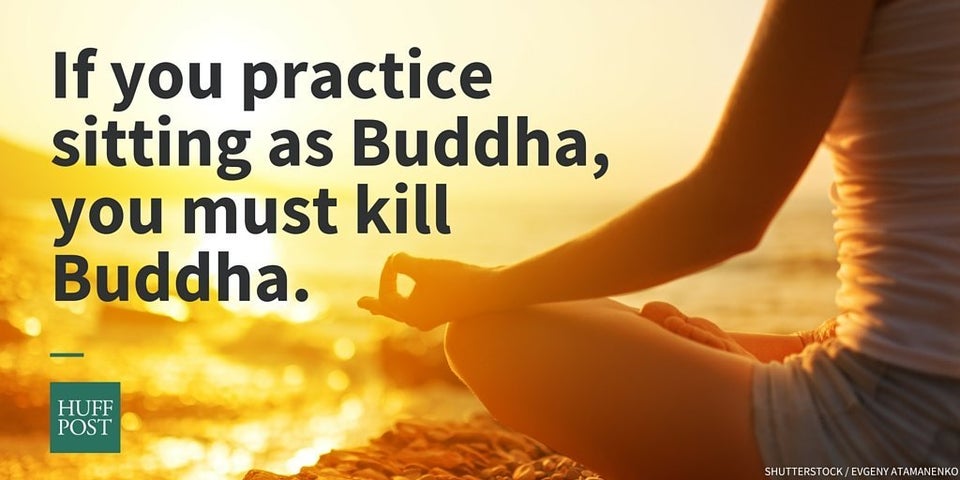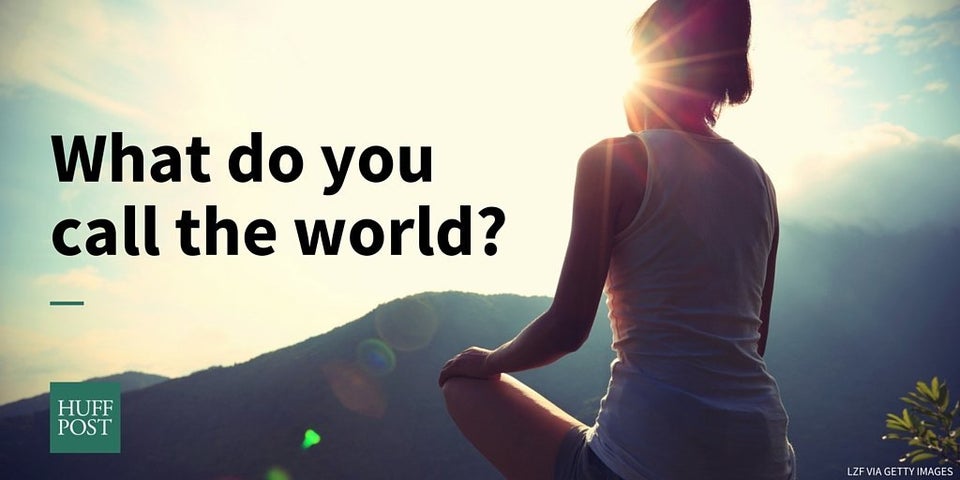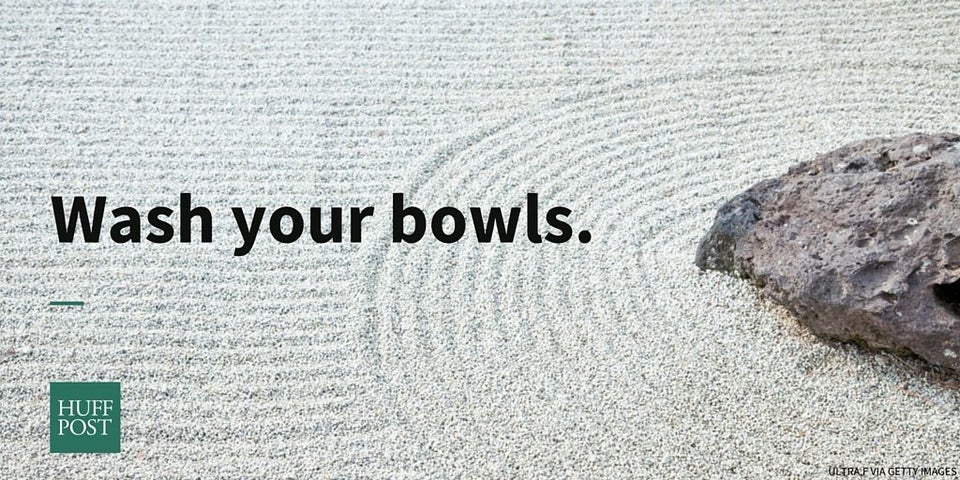A koan is a riddle or puzzle that Zen Buddhists use during meditation to help them unravel greater truths about the world and about themselves.
Zen masters have been testing their students with these stories, questions, or phrases for centuries. Many koans can be traced back to the collections of sayings amassed by Chinese priests in the 12th and 13th centuries.
Koans may seem like paradoxes at first glance. It is up to the Zen student to tease out their meaning. Often, after a prolonged and exhausting intellectual struggle, the student realizes that the koan is actually meant to be understood by the spirit and by intuition.
Don Dianda, author of "See for Your Self: Zen Mindfulness for the Next Generation," put it this way in a blog for Elephant Journal:
The koan serves as a surgical tool used to cut into and then break through the mind of the practitioner... Koans aren’t just puzzles that your mind figures out suddenly and proclaims, “Aha! the answer is three!” They wait for you to open enough to allow the space necessary for them to enter into your depths—the inner regions beyond knowing.
We asked a few of Zen Buddhists to share with us some koans that have been particularly useful in their practice. We hope their reflections will help you on your own spiritual journey.

Songwriter, Author, Father
When asked why he practiced zen, the student said, “Because I intend to become a Buddha.”
His teacher picked up a brick and started polishing it. The student asked “What are you doing?” The teacher replied, “I am trying to make a mirror.”
“How can you make a mirror by polishing a brick?”
“How can you become Buddha by doing zazen? If you understand sitting Zen, you will know that Zen is not about sitting or lying down. If you want to learn sitting Buddha, know that sitting Buddha is without any fixed form. Do not use discrimination in the non-abiding dharma. If you practice sitting as Buddha, you must kill Buddha. If you are attached to the sitting form, you are not yet mastering the essential principle.”
The student heard this admonition and felt as if he had tasted sweet nectar.
-- Dōgen Zenji
"As with most people, my spiritual struggle has always connected to the essence of this koan. It’s important to me because it relates to the question of effort: How can I step outside of my conventional desire to gain a result from meditation practice? How is it possible to practice meditation without attachment to the fruit of our efforts? I think approaching spiritual practice this way is impossible at first, because it almost pre-supposes a certain degree of enlightenment. And yet, if we are always thinking of meditation as a means to improve ourselves, to gain something from the effort and time we invest, the entire undertaking is subverted by our ordinary mind’s addiction to worldly achievement. The truth is, when we first take refuge in Buddha, our motivation is fear. We are afraid of suffering. We want change. Escape. Freedom. Only after we have gained some experience can we begin to shift the motivation, and explore these subtle traps of spiritual materialism. So this koan is a fantastic reminder to trust the purity of our primordial mind. To acknowledge our constant mental habit of grasping. And to see how grasping obscures our innate wisdom."

Zen priest, President of the San Francisco Zen Center
Dizang asked Xiushan, “Where do you come from?”
Xiushan said, “From the South.”
Dizang said, “How is Buddhism in the South these days?”
Xiushan said, “There is extensive discussion””
Dizang said, “How can that compare to me here planting the fields and making rice to eat?”
Xiushan said, “What can you do about the world?”
Dizang said, “What do you call the world?”
-- Book of Serenity
"Time and again during question and answer sessions after a Zen lecture, someone will ask: 'What is the use of just sitting in silent meditation when there is so much suffering in the world?' This question is usually meant as a challenge to what seems a kind of passiveness. It is true that the world is full of suffering beings; humans, animals, plants, even the planet itself is deeply suffering. Shouldn’t we be having extensive discussions, protesting, implementing solutions? This koan does for me what I think is the intention of all koans – it stops my mind in mid stride. It brings my awareness to the importance of asking questions before acting. Questions like: What is the nature of suffering and what is its ultimate cause? How can I help a world that I see as separate from myself? Wouldn’t it be more beneficial for me to deeply understand how the world is not something 'out there' that needs saving? If I consider the way we are all constantly, every moment, making the world then each simple, ordinary action I am able to take right here is 'doing something about the world.' And when it is time for other kinds of action, less simple or potentially more widely impactful, it is my intention that these actions will be grounded in not knowing what the world is, or what helping is."

Professor, Theology & Religious Studies, University of San Diego
Master [Hui-an] asked [Huai-jang], "Where are you coming from?"
Huai-jang said, "Mount Sung."
The Master said, "What sort of thing comes here like this?"
Huai-jang said, "To call it a 'thing' is to miss the mark."
The Master said, "Can it be cultivated or experienced?"
Huai-jang said, "It's not that it isn't cultivated or experienced, but rather that it isn't corrupted or defiled."
The Master said, "It's just because it isn't corrupted or defiled that it's treasured by all buddhas. You're like this. And I'm like this."
-- The Platform Sutra
"In 1982, when I received full ordination as a bhikkhuni (fully ordained Buddhist nun) in Pusan, Korea, the senior nun among the ordination masters was a remarkable master named Hye Chun Sunim. Born into a family of privilege in 1918 in northern Korea, her life was turned upside down by war in the early 1950s. When she traveled south as a refugee, she found solace in a Buddhist monastery and decided to become a nun. Determined to reach enlightenment, she went through unimaginable hardships to gain acceptance as a disciple of Songchol Sunim, the most famous Zen (Korean: Soen) master of her day – something unheard of for nuns at the time.
When I met Hye Chun Sunim one afternoon in a sparse tatami room at the monastery, she asked my name, in a very formal manner. I responded that my name was He Gong (Wisdom of Emptiness), a Korean name that had just been given to me by Kusan Sunim, the most renowned Zen master alive at that time. Suddenly, I heard my name ring out through the room: 'He Gong!' Startled, I responded, and she then asked, 'Who responded when I called your name?' The popular Korean koan ('What is this?') calls us to wake up to the moment and attend to whatever we are experiencing in the moment. Ultimately, it calls us to question the nature of the self. When the master called 'He Gong!' she called me to question my very identity. Wake up! Pay attention! Who are you anyway?!?"

Author, 'See for Your Self: Zen Mindfulness for the Next Generation'
Out of nowhere, the mind comes forth.
-- The Diamond Sutra
"Working with this koan alters how I might meet the world in two ways. In one twist, it opens life up in a way where I can’t expect anything to happen outside of the now, and in another, the koan takes my attention to my thoughts and opinions about what I come into contact with each moment. For example, I might see a tree and think 'out of nowhere the tree comes forth.' Deepening into understanding the present in this way gives an object a sudden miraculous quality. For a moment, the tree is mind-boggling and I begin to touch on something innate – beyond the confines of what I can conceive of or label. The fact that I take mundane shrubs, trees, stray cats, and rain squalls for granted or even consider them to be inconvenient nuisances at times is something the koan quietly forces me to examine more closely. What would life be like without these images, moments, and experiences? Do I create an inner world in which only some of what is present makes it through my ingrained mental filters? If yes, what would happen if I deconstructed these borders and removed them? Maybe everything that graces my life has a subtle extraordinariness and that allowing this connection to blossom on its own is a practice that takes place naturally when I just begin to notice."

Co-Founder of the New York Zen Center for Contemplative Care
Once a monk made a request of Joshu.
“I have just entered the monastery,” he said. “Please give me instructions, Master.”
Joshu said, “Have you had your breakfast?”
“Yes, I have,” replied the monk.
“Then,” said Joshu, “wash your bowls.”
The monk had an insight.
Mumon’s Poem
Because it is so very clear,
It takes longer to come to the realization.
If you know at once candlelight is fire,
The meal has long been cooked.
-- The Gateless Gate
"I love this koan. I am the student in the midst of my life, waiting for life to happen. I am the teacher pointing to this latte on my desk. I am the bowl that needs washing and the breakfast already eaten. How do we enter our life fully? It is right here. How do we want to live? Can we allow all the joys and sorrows to enliven us? Or do we just go along with all our patterns and habits? People who are dying always remind me: 'I can’t believe I wasn’t here for most of my life.' That’s one of the most common things I hear, and the biggest regrets. Many people have not inhabited their life because they’re just waiting for other moments. Are we waiting for life to happen in the midst of life? How can we give ourselves fully to our lives, moment to moment? Don’t wait. Life is always right here."
Also On HuffPost:
